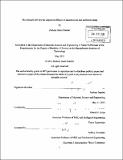| dc.contributor.advisor | Darrell J. Irvine. | en_US |
| dc.contributor.author | Stauber, Zachary Jason | en_US |
| dc.contributor.other | Massachusetts Institute of Technology. Dept. of Materials Science and Engineering. | en_US |
| dc.date.accessioned | 2013-01-07T21:23:06Z | |
| dc.date.available | 2013-01-07T21:23:06Z | |
| dc.date.copyright | 2012 | en_US |
| dc.date.issued | 2012 | en_US |
| dc.identifier.uri | http://hdl.handle.net/1721.1/76127 | |
| dc.description | Thesis (S.B.)--Massachusetts Institute of Technology, Dept. of Materials Science and Engineering, 2012. | en_US |
| dc.description | Cataloged from PDF version of thesis. | en_US |
| dc.description | Includes bibliographical references (p. 51-53). | en_US |
| dc.description.abstract | Two classes of drugs, antiretrovirals and antibiotics, could benefit greatly from delivery through microneedles. Microneedles (MN) offer an increase in efficacy for these drugs by providing delivery to the lymphatic system through the skin, thus avoiding first pass metabolism and allowing more focused delivery to specific viral or bacterial reservoirs. Furthermore, microneedles present other advantages in the form of the ability to be self-administered, tunable controlled release, and painless administration. Saquinavir and Ciprofloxacin, an antiretroviral and an antibiotic respectively, were chosen for their optimal properties, including bioavailability, half-life, and dosage. Saquinavir was encapsulated in the organic phase of biodegradable poly(lactide-co-glycolide) microparticles (MP) synthesized through a double emulsion. Similarly, Ciprofloxacin was encapsulated in the aqueous phase of the microparticles. In addition, Ciprofloxacin microcrystals were synthesized. The microparticles and microcrystals were then loaded into molded polymer microneedles in a poly-acrylic acid (PAA) matrix. Standard curves were created for the two drugs from known concentrations and used to show the drug loading in the microparticles and microneedles. The Saquinavir microparticles showed a maximum loading of 1.35% the mass of particles and the Ciprofloxacin microparticles showed a maximum loading of 0.197%. The Saquinavir microparticle microneedles had a maximum loading of 11.95 [mu]g of Saquinavir per 1 cm² array and the Ciprofloxacin microparticle microneedles had a maximum loading of .41 [mu]g of Ciprofloxacin per 1 cm² array. The Ciprofloxacin microcrystal microneedlees had a maximum loading of 165 [mu]g per 1 cm² array. Analysis based on insulin delivery through microneedles showed these loadings to be too low to create the sufficient minimum drug concentration in plasma. However, there exist multiple strategies to increase the loading of the drugs in the microneedles. These results proved promising for the use of microneedles for the delivery of antiretroviral and antibiotic drugs. | en_US |
| dc.description.statementofresponsibility | by Zachary Jason Stauber. | en_US |
| dc.format.extent | 53 p. | en_US |
| dc.language.iso | eng | en_US |
| dc.publisher | Massachusetts Institute of Technology | en_US |
| dc.rights | M.I.T. theses are protected by
copyright. They may be viewed from this source for any purpose, but
reproduction or distribution in any format is prohibited without written
permission. See provided URL for inquiries about permission. | en_US |
| dc.rights.uri | http://dspace.mit.edu/handle/1721.1/7582 | en_US |
| dc.subject | Materials Science and Engineering. | en_US |
| dc.title | Microneedle delivery for improved efficacy of antiretroviral and antibiotic drugs | en_US |
| dc.type | Thesis | en_US |
| dc.description.degree | S.B. | en_US |
| dc.contributor.department | Massachusetts Institute of Technology. Department of Materials Science and Engineering | |
| dc.identifier.oclc | 821214193 | en_US |
